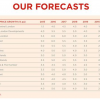
SW house price growth of 24% predicted over next five years
The UK housing marketing is entering a new phase. It has been through a boom, a bust and a recovery cycle, and as we head into 2015 and a year that will see the formation of a new Government, we are now entering a more stable, yet still challenging era.
That’s according to leading property consultancy JLL’s new Residential Market Review, published this month which predicts that South West house prices will rise by 4% in 2015 and 24% over the next five years. This rate of increase is second only to London and the South East and faster than the UK average.
The new report The Supply Conundrum states that the last 12 months have seen numerous factors contribute to rising house price growth and a more buoyant UK housing market. Economic growth, rising employment levels and wage growth are contributing to greater confidence as the UK economy strengthens to its most positive position in 5 years. And this activity, assisted by initiatives such as Help to Buy has translated directly into increased housing demand from both new and existing owners as consumer confidence returns.
Equity has been an important driver of demand; 7.2 million households own their home outright which equates to 33% of all households in the UK.
But with this increased activity has come challenges. Property ownership is becoming increasingly restricted to the wealthy and we are seeing the biggest gap to date between London and the rest of the UK. But the biggest problem facing the UK housing market is the lack of supply. Housing starts in England have increased to 137,000 units in the year to Q2 2014, but with the number of households set to rise by over 220,000 a year in the coming decade, even this escalation in housebuilding activity is woefully insufficient. This has created much of the upward pricing pressure that we have seen over the last 12 months.
As we enter 2015 we expect external factors to be broadly supportive of the UK housing market and as a result have predicted UK house price growth of 4% for 2015. We predict growth in Prime Central London will stand at 1.5% but it is the South East and Greater London that will see the greatest rises of 5% and 5.5% respectively, closely followed by the South West, in line with the national average at 4% for 2015 but rising at a higher than average rate over the next five years. We forecast that transactions across the UK will increase from current levels and then stabilise at around 1.13m pa. We expect housing completions in England to grow from around 120,000 to 150,000 pa over the next five years, still vastly below the level of supply needed to meet demand.
The general election will have little effect on the UK housing market and the results will not govern whether people buy, sell or move house. However, the prospects of a base rate rise, with current projections suggesting that it will move from 0.5% to 1.5% by the end of 2015, will influence activity. The problems of affordability, raising a deposit and being able to secure a mortgage will also rein back activity and price growth.
JLL predict further activity into 2016 as the new Government stabilises and beds in, and the economy continues on its upward trajectory of recovery. Constrained price growth and transactional activity will still be evident as activity levellers continue to dominate but external support such as Help to Buy may ease these constraints to a degree.
Commenting on the current market and year ahead, Scott Grant, director in JLL’s South West residential team said: “The UK is facing a housing crisis and the South West - with its high employment rates, excellent quality of life, and rapidly growing strengths in a range of sectors, is becoming a victim of its own success. A rise in retirement living and residential care provision in the region is also a significant factor.
“With prices rising here at a rate second only to London and the South East, housing is in ever greater demand whilst supply remains worryingly slow to come through.
“A creative and rational approach to house building is required at all levels in order to ensure the region continues to maximise its economic potential.”
Adam Challis – Head of Residential Research at JLL concludes: “An improving economic backdrop, a generally supportive Government and demand that seems inclined to carry on driving transactions - despite affordability challenges looming - all suggest that the market is leaning towards a period of sustained, stable improvement. But unless we can make serious inroads into meeting the UK’s long-term supply requirements, that stability will be on shaky ground.
And here’s the rub. Despite a range of supportive Government programmes, builders ultimately need to build and supply chains are likely to take another couple of years before ‘normality’ can resume. Will this choke off supply growth? Will this spur innovations like off-site construction or the use of new materials? Where will sustainability fit in; squeezed as ever between regulation and profitability?
Even in calmer waters, a level of uncertainty always lurks beneath.”















